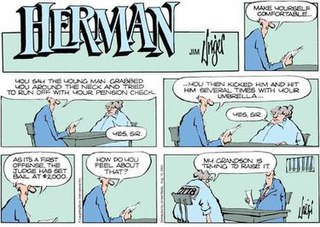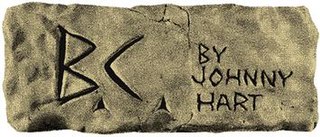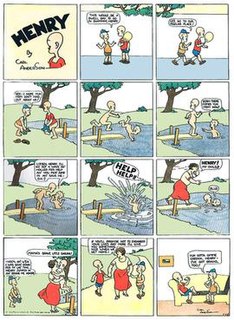Related Research Articles

A comic strip is a sequence of drawings, often cartoons, arranged in interrelated panels to display brief humor or form a narrative, often serialized, with text in balloons and captions. Traditionally, throughout the 20th and into the 21st century, these have been published in newspapers and magazines, with daily horizontal strips printed in black-and-white in newspapers, while Sunday papers offered longer sequences in special color comics sections. With the advent of the internet, online comic strips began to appear as webcomics.

Gasoline Alley is a comic strip created by Frank King and distributed by Tribune Content Agency. It centers on the lives of patriarch Walt Wallet, his family, and residents in the town of Gasoline Alley, with storylines reflecting traditional American values.

Mutt and Jeff is a long-running and widely popular American newspaper comic strip created by cartoonist Bud Fisher in 1907 about "two mismatched tinhorns". It is commonly regarded as the first daily comic strip. The concept of a newspaper strip featuring recurring characters in multiple panels on a six-day-a-week schedule had previously been pioneered through the short-lived A. Piker Clerk by Clare Briggs, but it was Mutt and Jeff as the first successful daily comic strip that staked out the direction of the future trend.

John Lewis Hart was an American cartoonist noted as the creator of the comic strips B.C. and The Wizard of Id. Brant Parker co-produced and illustrated The Wizard of Id. Hart was recognized with several awards, including the Swedish Adamson Award and five from the National Cartoonists Society. In his later years, he was criticized for incorporating Christian themes and messages into his strips. Hart was referred to by Chuck Colson in a Breakpoint column as "the most widely read Christian of our time," over C. S. Lewis, Frank E. Peretti, and Billy Graham.
Randy Glasbergen was an American cartoonist and humorous illustrator best known for three decades of newspaper syndication as well as a freelance career. He produced the syndicated strip The Better Half from 1982 to 2014.

Herman is a comic strip written and drawn by Jim Unger. While the daily ran as a single panel with a typeset caption, it expanded every Sunday as a full multi-panel strip with balloons.

King Features Syndicate, Inc., is a print syndication company owned by Hearst Communications that distributes about 150 comic strips, newspaper columns, editorial cartoons, puzzles, and games to nearly 5,000 newspapers worldwide. King Features Syndicate is a unit of Hearst Holdings, Inc., which combines the Hearst Corporation's cable-network partnerships, television programming and distribution activities, and syndication companies. King Features' affiliate syndicates are North America Syndicate and Cowles Syndicate. Each week, Reed Brennan Media Associates, a unit of Hearst, edits and distributes more than 200 features for King Features.

B.C. is a daily American comic strip created by cartoonist Johnny Hart. Set in prehistoric times, it features a group of cavemen and anthropomorphic animals from various geologic eras.

Nancy is an American comic strip, originally written and drawn by Ernie Bushmiller and distributed by United Feature Syndicate and Andrews McMeel Syndication. The strip was originally called Fritzi Ritz, but over several years, the focus changed from ditzy Fritzi to her niece Nancy, who got her own Sunday topper strip starting October 3, 1938.

Steve Canyon was an American adventure comic strip by writer-artist Milton Caniff. Launched shortly after Caniff retired from his previous strip, Terry and the Pirates, Steve Canyon ran from January 13, 1947, until June 4, 1988. It ended shortly after Caniff's death. Caniff won the Reuben Award for the strip in 1971.

Henry was a comic strip created in 1932 by Carl Thomas Anderson. The title character is a young bald boy who is mute. With the exception of a few early episodes, the comic strip character communicates only through pantomime, a situation which changed when Henry moved into comic books.
United Feature Syndicate is a large American editorial column and comic strip newspaper syndication service based in the United States and established in 1919. Originally part of E. W. Scripps Company, it was part of United Media from 1978 to 2011, and is now a division of Andrews McMeel Syndication. United Features has syndicated many notable comic strips, including Peanuts, Garfield, Li'l Abner, Dilbert, Nancy, and Marmaduke.

The Newspaper Enterprise Association (NEA) is an editorial column and comic strip newspaper syndication service based in the United States and established in 1902. The oldest syndicate still in operation, the NEA was originally a secondary news service to the Scripps Howard News Service; it later evolved into a general syndicate best known for syndicating the comic strips Alley Oop, Our Boarding House, Freckles and His Friends, The Born Loser, Frank and Ernest, and Captain Easy / Wash Tubbs; in addition to an annual Christmas comic strip. Along with United Feature Syndicate, the NEA was part of United Media from 1978 to 2011, and is now a division of Andrews McMeel Syndication. The NEA once selected college All-America teams, and presented awards in professional football and professional [NBA] basketball.

The Lockhorns is a United States single-panel cartoon created September 9, 1968 by Bill Hoest and distributed by King Features Syndicate to 500 newspapers in 23 countries. It is continued today by Bunny Hoest and John Reiner.

The Sunday comics or Sunday strip is the comic strip section carried in most western newspapers, almost always in color. Many newspaper readers called this section the Sunday funnies, the funny papers or simply the funnies.
Robert Leslie Barnes was an American comic strip artist most notable for his marriage-themed gag panel The Better Half.

Little Iodine was an American Sunday comic strip, created by Jimmy Hatlo, which was syndicated by King Features and ran from August 15, 1943 until August 14, 1983. The strip was a spin-off of They'll Do It Every Time, an earlier Hatlo creation.

Toots and Casper was a long-run family comic strip by Jimmy Murphy, distributed to newspapers for 37 years by King Features Syndicate, from December 17, 1918 to December 30, 1956. The strip spawned many merchandising tie-ins, including books, dolls, paper dolls, pins, bisque nodders and comic books.

Frank and Ernest is an American comic strip created and illustrated by Bob Thaves and later Tom Thaves. It debuted on November 6, 1972, and has since been published daily in over 1,200 newspapers. The humor of the comic is based almost exclusively on wordplay and puns.
The Register and Tribune Syndicate was a syndication service based in Des Moines, Iowa, that operated from 1922 to 1986, when it was acquired by King Features to become the Cowles Syndicate affiliate. At its peak, the Register and Tribune Syndicate offered newspapers some 60 to 75 features, including editorial cartoonist Herblock, comic strips, and commentaries by David Horowitz, Stanley Karnow, and others.
References
Notes
- 1 2 Holtz, Allan (2012). American Newspaper Comics: An Encyclopedic Reference Guide. Ann Arbor: The University of Michigan Press. p. 70. ISBN 9780472117567.
Sources
- Strickler, Dave. Syndicated Comic Strips and Artists, 1924-1995: The Complete Index. Cambria, California: Comics Access, 1995. ISBN 0-9700077-0-1
- "NCS Awards: Newspaper Panel" . Retrieved 6 December 2008.